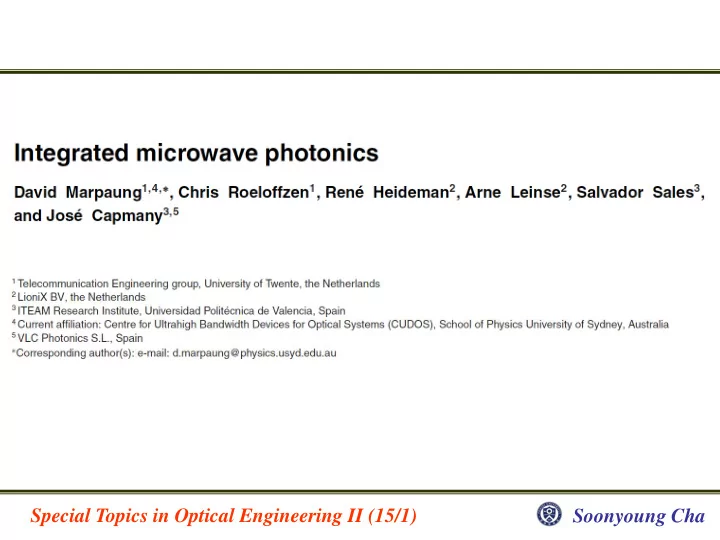

Special Topics in Optical Engineering II (15/1) Soonyoung Cha
Contents • Introduction • Review of integrated microwave photonics • Review: Arbitrary waveform generation • Conclusion Special Topics in Optical Engineering II (15/1) Soonyoung Cha
Introduction Digital electronics - Widely used nowadays - Speed of DSPs > several GHz (Limit from sampling rate) Processing in optical domain Solution of limitation - Front-end analog signal process - Microwave photonics (MWP) :Bulky, expensive, not flexible Integrated Microwave Photonics Special Topics in Optical Engineering II (15/1) Soonyoung Cha
Category of MWP applications High dynamic range MWP link Microwave photonic filters Optical delay line & beamforming Microwave signal generation Special Topics in Optical Engineering II (15/1) Soonyoung Cha
Ultrabroad-bandwidth arbitrary waveform generation Electronic arbitrary waveform generation (AWG) - Limited in frequency and bandwidth - Maximum bandwidth of 5.6 GHz - Maximum frequency up to 9.6 GHz Progress on MWP-based AWG techniques Direct space-to-time pulse shaper Wavelength-to-time mapping Generated by spatial pattern & distance Suitable for time time-stretch operation J. D. McKinney, D. E. Leaird, and A. M. Weiner, Opt. Lett . 27 (15), J. Chou, Y. Han, and B. Jalali, IEEE Photonics Technol . Lett . 15 (4), 1345 – 1347 (2002). 581 – 583 (2003). Optic device: expensive, complicated, bulky → On -chip integrated pulse shaper Special Topics in Optical Engineering II (15/1) Soonyoung Cha
Ultrabroad-bandwidth arbitrary waveform generation Special Topics in Optical Engineering II (15/1) Soonyoung Cha
Ultrabroad-bandwidth arbitrary waveform generation On-chip spectral shaper Broadband optical source 8 cascaded microring resonators - Power transfer at resonant wavelength of each microring Femtosecond laser pulse : Creates dip in the output spectrum - 100 fs pulse duration - Microrings: slightly different resonance - 1,525 ~ 1,610 nm band - Coupled into Si waveguide Micro-heater - Local & independent control of temperature of each rings : Resonance λ can be tuned (thermo-optical effect of Si) Special Topics in Optical Engineering II (15/1) Soonyoung Cha
Ultrabroad-bandwidth arbitrary waveform generation Output after resonators RF conversion 5.5 km single-mode fiber Chromatic dispersion: propagate different speeds for λ Same shape of the optical spectrum(10GHz) - Pulse envelope is broadened (wavelength-time mapping) → Tunable profile → Time-domain profile follows spectral shape Controllable RF waveform generation using microring silicon photonics Special Topics in Optical Engineering II (15/1) Soonyoung Cha
Ultrabroad-bandwidth arbitrary waveform generation Problem First-generation design: Heating the ring itself cannot lead wide λ control Solution: Mach-Zehnder (MZ) input coupler & heat this coupler Second-generation design Phase shift : 0 π Thermally tuning the phase shift of two arms → Coupling coefficient into a ring changes → Loaded quality factor changes Special Topics in Optical Engineering II (15/1) Soonyoung Cha
Ultrabroad-bandwidth arbitrary waveform generation Optical signals from the common port: consists of peaks (dip for output signal) Tunable waveform shape Application for apodization : control the suppression of side lobes in Fourier transform domain (Used in signal & filter design) Without apodization Flat-topped envelope : Weak side-lobe suppression ~ -12 dB With apodization Waveform with uppressed edge : Enhanced side-lobe suppression ~ -20 dB Special Topics in Optical Engineering II (15/1) Soonyoung Cha
Ultrabroad-bandwidth arbitrary waveform generation Phase shift inside waveform 4 cycle – phase shift – 4 cycle (10 GHz) : Doublet in the RF spectrum (dip @ 10 GHz) → Phase shift within the pulse burst 60 GHz waveform with π -phase shift : Strong dip near 60 GHz → Beyond the edge of time -domain electronic measurement instrumentation Could contribute to the realization of multi-GHz BW Wireless LAN, portable multimedia streaming, vehicular networks, etc. Special Topics in Optical Engineering II (15/1) Soonyoung Cha
Ultrabroad-bandwidth arbitrary waveform generation Frequency-modulated waveforms Two-tone waveform - Abrupt frequency change : 60 GHz to 40 GHz in single waveform - Difficult to achieve using electronic circuits Chirped waveform : Sweep from low to high freq. (up) : Sweep from high to low freq. (down) Special Topics in Optical Engineering II (15/1) Soonyoung Cha
Conclusion • Integrated microwave photonics : to avoid bulky & expensive & complicated system • Limitation of current DSP-based electronics • Arbitrary waveform generation using MPF system : High-frequency up to tens of GHz • On-chip implementation of MPF-based AWG system Special Topics in Optical Engineering II (15/1) Soonyoung Cha
Reference D. Marpaung et al., Laser Photonics Rev. 7, 506 – 538 (2013) J. D. McKinney, D. E. Leaird, and A. M. Weiner, Opt. Lett . 27 (15), 1345 – 1347 (2002). J. Chou, Y. Han, and B. Jalali, IEEE Photonics Technol . Lett . 15 (4), 581 – 583 (2003). Lin, I. S., McKinney, J. D. & Weiner, A. M. IEEE Microw. Wirel. Compon. Lett. 15 , 226 – 228 (2005). M. H. Khan et al., Nat. Photonics 4 , 117-122 (2010). Special Topics in Optical Engineering II (15/1) Soonyoung Cha
Recommend
More recommend